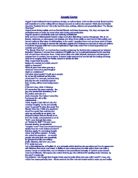CONSIDER THE WAYS IN WHICH CARTER BLENDS ANIMAL AND HUMAN CHARACTERISTICS IN THE BLOODY CHAMBER. HOW DOES THIS CONTRIBUTE TO THE DESTINATION OF THE STORIES/COLLECTION?
consider the ways in which carter blends animal and human characteristics in ‘the bloody chamber’. how does this contribute to the destination of the stories/collection?
In ‘The Bloody Chamber’, Angela Carter uses the blurring of boundaries between animal and human qualities, usually through characters which are ‘liminal beings’, to overtly direct readers towards a destination concerning identity. In many of the individual stories, the concept of liminality is used to show how tortured and unsure creatures (be they animals or women) come to embrace their identity. In addition to these journeys of self-discovery in individual stories, the balance and degrees of liminality shift as the whole collection progresses, again leading to an overarching destination concerning identity, as the collection goes from a simple and negative liminality to more affirming and complex liminality.
The ’simple and negative’ liminality occurs in the very first story of the collection: ‘The Bloody Chamber’. Here, the Marquis de Sade is portrayed as a sadistic animal (as his name suggests) parading as a connoisseur, a man of sophistication. Indeed, the female narrator identifies his bestiality before she discovers his violent sadism, with constant references to his lion-like physique (“dark leonine shape of his head”, “as if all his shoes had soles of velvet”, “There were pure streaks of silver in his dark mane”). The Marquis’ animalism is a constant in the story; it does not change or develop, as in other stories. This liminality, then, serves only to highlight Carter’s view of powerful men as vicious brutes who objectify and humiliate women, which she extracts from the “latent content” of the eponymous character of the traditional fairy tale ‘Bluebeard’. The first instance of liminality in the collection, then, is a relatively two dimensional affair, with the capacity for animalism in men being exposed and, ultimately, triumphed over through the strength of maternal instincts. Henceforth, however, Carter approaches the blurring of boundaries between humans and animals in a much less straightforward and more positive way, starting with the next two stories in the collection, ‘The Courtship of Mr Lyon’ and ‘The Tiger’s Bride’.

This is a preview of the whole essay
Peer Reviews
Here's what a star student thought of this essay
Quality of writing
I would've liked to have seen quotes embedded thoroughly into the essay rather than placed in parenthesis. Although it does not detract from the content of the essay, placing quotes at the end makes it seem they are after-thoughts, whereas the quotes should be at the centre of any discussion. It was a shame to see a couple of colloquial phrases such as "flings all convention away" as these do manage to detract from what is strong analysis. Spelling, punctuation and grammar are strong. I really liked the critical voice here, and the style of the essay is one which shows fluency and the ability to write a convincing essay.
Level of analysis
This essay manages to analyse the high level concepts of magical realism and animalistic descriptions and emotions. The choice of language is analysed well here, and there is always discussion around the purpose of Carter's techniques. Phrases such as "This shows Carter challenging societal norms even further" allows the examiner to see you aren't simply commenting on techniques for the sake of it, but instead you're using them to build a cogent argument. What I really liked about this essay was the range of textual evidence. They don't just focus on one short story, but look at the short stories as a collection, trying to decipher a more broad meaning from Carter's texts. Such discussion is highly rewarded by examiners.
Response to question
This essay is particularly strong. Not only does this essay respond to the question by looking at the blending of animal and human characteristics, but there is a distinct appreciation and exploration of why Carter does this. I would've liked to have seen some more discussion around the gothic: there are great references to liminality and blurring of boundaries, but confirming Carter's text in the gothic genre would've made this essay even stronger. I particularly liked how liminality was defined from the introduction, as this allows the argument to stay focused throughout.








